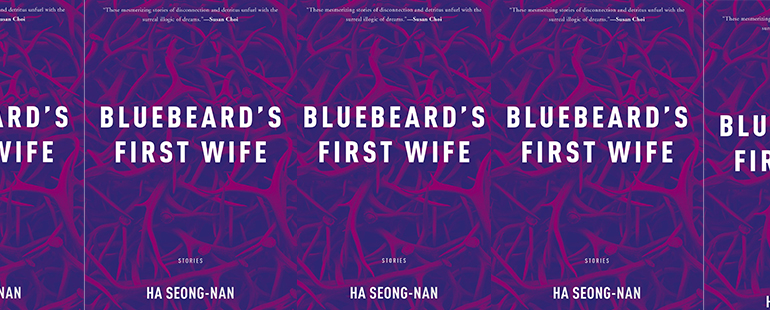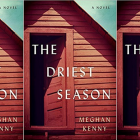Ha Seong-nan’s Bluebeard’s First Wife

Bluebeard’s First Wife
Ha Seong-nan
Open Letter | June 16, 2020
In the title story of Angela Carter’s collection of reworked fairy-tales, The Bloody Chamber, Bluebeard and his new bride have sex for the first time. The affluent wife-killer of French folklore has lured his latest wife with jewels and gemstones and has warned her to steer clear of one room in his castle—the one where he keeps his former wives’ corpses. Carter describes the moment when the bride’s virginity is taken with an opulent tone befitting a medieval fairy-tale—as they do the deed, “mewing gulls [swing] on invisible trapezes in the empty air outside.” Yet a ringing telephone breaks the spell. It’s Bluebeard’s “agent in New York” calling, beckoning him to a Wall Street meeting. The scene turns from fairy-tale into something out of HBO’s Succession.
In Ha Seong-nan’s second short story collection, Bluebeard’s First Wife, translated from the Korean by Janet Hong, the presence of the fairy-tale—and the ways it’s updated and upended—is subtler. Without the collection’s title to hint at this potential interpretive lens, it might even go unnoticed. Whereas Carter’s retold tales play on the disjuncture between the legendary and the actual, Ha’s stories are entirely grounded in a mundane everyday—no fanfare, no castles—often centering on women’s experiences in contemporary South Korea. These women are exhausted. When single, they are oppressed by the expectation that they should marry; when married, they are oppressed by their husbands. Stripped of their thickly-slabbed-on symbolism, fairy-tales are essentially this, too—stories of domestic strife, heightened accounts of common human troubles, cautionary tales about the ways our inescapable psychology can lead us down wrong paths, be they figurative or those found in dark forests. Ha is invested not in the myth itself but in what it helps us see. In her hands, the fairy-tale works as a photo filter, bringing into clearer relief her actual subject: the horrors of daily contemporary life. This is a place where at your most vulnerable, you will encounter no fairy godmother, no knight will rush in on a horse.
In Ha’s first story, “The Star-Shaped Stain,” we are tricked by a light-hearted opening scene. A woman is unsatisfied with her child’s school photos. She rifles through pictures, annoyed at the way her daughter eludes the photographer in each one. She is chastised by her husband for not talking to the teachers beforehand, not bribing them to secure a better shot. As with many of Ha’s stories, the main characters are known only by titles—“the woman,” “her husband,” and “her daughter,” imbuing them with a distance. The tone takes a quick turn as we learn that the daughter had died in a fire at a children’s summer camp, and that the woman and her husband are preparing for the annual parents’ trip to the campsite. The story becomes about the schism that develops in a marriage after the loss of a child and the painful side of hope, of believing that the child is alive, of refusing to accept facts. Ha presents this hope as a gendered phenomenon: the mothers are significantly more invested in pursuing the possibility that their child had somehow survived. In the closing scene, the husband says to the woman, “Stop this nonsense . . . Let’s forget and move on.”
Like the many stains that appear in folktales—bloodstains, stains that will not wash out—a stain on the child’s camp uniform becomes a central focus point of the story. A drunkard of dubious credibility claims to have witnessed a girl escaping from the fire. The child had something like a stain on her, he says, and the woman is sure this means it was her daughter. With the stain, Ha returns to the theme of women’s labor, their exhaustion. The story’s most poignant moments are the woman’s recollections of how she failed as a mother: late in picking up her kid from kindergarten, too tired to make her breakfast, easily annoyed, and forgetting to wash out that stain in time for the first day of summer camp. The pain of the loss is doubled for her—in ways that it is not for the husband—in large part due to this burden of living with her shortcomings in the expected role of mother.
The titular “Bluebeard’s First Wife” skillfully defies following the plot or lessons of the original folktale. The world of fairy-tales is present only in references to a wardrobe made of a special wood from a tree planted by the narrator-bride’s father. The juxtaposition between this almost-magical wardrobe and the context in which the wardrobe sits is as jarring as a New York agent calling Bluebeard’s landline. The wardrobe belongs to a pharmacist from Seoul who feels both past her prime and lucky to have found a well-off man to marry. Her husband is a Korean immigrant living in New Zealand and going by his English name, Jason. The woman is lonely as she immigrates to Wellington, while Jason is distant and brooding, infinitely more attentive to his friend Chang. Eventually, the wife discovers that Jason and Chang are lovers and that Jason’s parents, unaccepting of his homosexuality, had threatened to cut him off financially if he didn’t marry a woman.
Catching Jason and Chang in a sexual act is meant to mirror Bluebeard’s bride’s discovery of his forbidden chamber of corpses. Shock and horror mark the latter finding, yet in Ha’s story, the wife’s reaction couldn’t be more different. She is fully accepting of what is happening, understanding how many are pressured to keep up the pretense of a heteronormative relationship. The reader, too, is unsurprised—from the start, the men’s intimacy was conspicuous. In the end, it is Jason’s parents who are the medieval Bluebeards. In trying to blackmail their son, their behavior comes off as heinous.
In the original folktale, the bride escapes the fate of her predecessors. Just before Bluebeard can sever her head, her brothers come to the rescue. Bluebeard’s head rolls instead and the bride inherits his fortune. In Ha’s version, an even more violent scene ensues. Yet it’s the narrator’s numb, accommodating nature that is the most horrifying part of this story. After she is nearly murdered by Jason and Chang, her aim is simply to be allowed to return to Korea. There is a sense that she feels she “had it coming,” that her fate was too good to be true. She is a woman over thirty, after all; not even the pharmacies back in Seoul want to hire her. In the closing scene, the woman isn’t dwelling on the horror of her near-murder or the shame of a sham marriage. Instead, she reminisces about New Zealand’s pretty landmarks and her matrimonial house. She’s unscathed, it seems, entirely accepting of life’s blows. Having lived as a princess for a flash, she finds she’s more comfortable accepting the role of old maid. Her shocking complacency—her bland acceptance of these misogynist tropes—is the story’s real source of horror.
Throughout the collection, Ha introduces fairy-tale tropes in more overt—yet still non-committal—ways in stories such as “Night Poaching,” where the warning, “Do not go in the woods” is repeated as a detective investigates the death of a deer farm worker. A mother’s echoing caution to her daughter, “Never get in a taxi alone at night,” appears in “Pinky Finger,” where a woman returning home from a party regrets having failed to heed the warning. Ha dangles the fantastical most teasingly in “A Quiet Night,” in which a husband, frustrated by the noise caused by the upstairs neighbors’ children, says he wishes a Pied Piper would come to take them away. The narrator-wife is amused: “It seemed my husband didn’t remember the ending of the fairy tale. Not all the children followed the Pied Piper of Hamelin. One child was lame and could not follow quickly enough. Even if the pied piper should come, at least one child would remain and forever torment our sleep with the thump of his crutches.” When the children go missing and the husband is arrested, the wife is forced to consider what her spouse is truly capable of. Real life meets fairy-tale and the result, for her, is a nightmare.
Where Ha offers more conspicuous references to myth, as with the Pied Piper—and we recognize the characters whose names we heard as children—the result underscores just how far removed her characters are from a fabulous world of magic. In “A Quiet Night,” the real Pied Piper, or kidnapper, turns out to be the children’s father’s embittered mistress. In “Bluebeard’s First Wife,” when Jason and Chan attempt to murder Jason’s wife, no one comes to her rescue the way they do for Bluebeard’s bride; she is an isolated, lonely immigrant and must fend entirely for herself. Considering the ways her life could have gone if only the princes and knights we anticipated had materialized only underscores Ha’s characters’ unremarkable fates.
T.S. Eliot said of the function of myth in Ulysses, “It is simply a way of controlling, of ordering, of giving shape and significance to the immense panorama of futility and anarchy which is contemporary history.” Likewise, Ha is not concerned with updating fairy-tales, she is not seeking to transport readers to a mythical realm. A concise lesson, the neat happy bow of a fairy-tale ending, is never offered. She instead uses myth to make visible the human condition—one marked by disappointment, loneliness, and loss.



